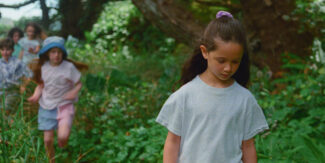Seagrass (Meredith Hama-Brown, 2024): Canada
Reviewed by Anna Henningsen at the 2024 Santa Barbara International Film Festival.
How do we hold ourselves accountable for our actions? Around the halfway mark of my time spent at SBIFF this year, I saw Seagrass. This was up-and-coming Japanese Canadian director Meredith Hama-Brown’s first feature film! It stars Ally Maki (Toy Story 4, Shortcomings), Luke Roberts (Batman, Pirates of the Caribbean: On Stranger Tides), and Chris Pang (Crazy Rich Asians, Charlie’s Angels). More importantly, it stars Nyha Huanga Breitkreuz and Remy Marthaller, who are child actors whose performances were incredible. It was produced by Ceroma Films, who also produced Until Branches Bend and Be Still.
The dramatic piece follows a Japanese Canadian woman named Judith, who while grappling with the loss of her mother, decides to take her family to a remote seaside retreat that seemingly focuses on couples’ counseling. Her behavior and relationship with her husband Steve become unstable as the film progresses, negatively affecting her young daughters Stephanie and Emmy, who each have battles of their own. Judith is heavily influenced by another couple, who foils Judith and Steve as a perfect example of a lovely interracial couple who don’t struggle to communicate with one another. The cinematography of the film is phenomenal- probably my favorite aspect of the whole film- with shots of the dangerous tide and beach scenery strategically folded into the story. Additionally, the writing was masterfully crafted so that the havoc Judith wreaks on her family is gradual and in small pieces, as she loses sight of herself and pushes them away more and more. It’s different from most dramas in that way; I like it when the intrigue is not handed to audiences as directly and we are meant to search for the inferred context.
The film tackles the complex theme of racial identity, specifically how it manifests at different ages. For example, there is a scene where the younger daughter Emmy laughs along as some other children at the retreat make racist gestures towards her, even making the same gesture herself in the mirror later that day, greatly upsetting Judith. Judith, on the other hand, fields racism in the verbal form from her own husband, who claims that he can’t be racist because he is married to her. This pushes her away from him and towards Pat (from the aforementioned model couple), who she finds herself drawn to as they share a similar upbringing and cultural background.
One last thing of note that I haven’t touched on with other film reviews is the costume design. The story is set in the 90s, which is made clear almost fully due to the clothing choices (and maybe 10% due to the soundtrack). The young girls wear scrunchies and colorful bright shirts and dresses, while Judith sports the classic t-shirt under a floral sundress look. I think the lack of modern technology distracting the characters is a solid choice on Hama-Brown’s part. I will be curious to see what she does next and would recommend this film to others in search of a more unique story!
About this entry
You’re currently reading “Seagrass (Meredith Hama-Brown, 2024): Canada,” an entry on Student Film Reviews
- Published:
- 02.27.24 / 10am
- Category:
- Films, Santa Barbara Film Festival 2024

2 Comments
Jump to comment form | comments rss [?]